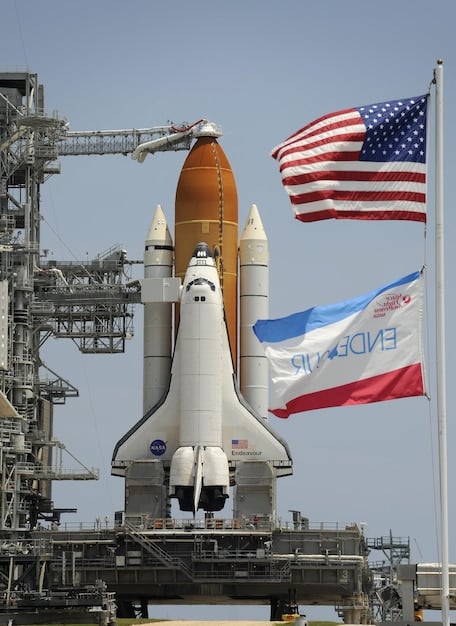Space Tourism: Examining the Economic Impact on the US

Space tourism is poised to significantly impact the U.S. economy, driving innovation, creating jobs, and generating revenue, while also presenting challenges related to infrastructure, regulation, and environmental sustainability.
The allure of space tourism is no longer confined to science fiction; it’s rapidly becoming a tangible reality. As companies like SpaceX, Blue Origin, and Virgin Galactic pioneer ventures beyond Earth’s atmosphere, the question arises: what is the economic impact of space tourism takes off: what’s the economic impact on the US?
The Dawn of Space Tourism: A New Frontier
Space tourism, once a distant dream, is now on the cusp of becoming a viable industry. With successful suborbital flights and ambitious plans for orbital and lunar tourism, the sector is attracting significant attention and investment. This burgeoning industry holds the potential to redefine travel and exploration while simultaneously sparking economic growth.
Early Pioneers and Key Players
The initial steps into space tourism have been largely driven by a handful of pioneering companies. These include Virgin Galactic, which focuses on suborbital flights, Blue Origin, with its ambitions for space hotels and lunar missions, and SpaceX, aiming for orbital tourism and beyond. Their successes and innovations are paving the way for others to enter the market.
Suborbital vs. Orbital Tourism Models
Space tourism encompasses various models, primarily suborbital and orbital flights. Suborbital flights offer a brief experience of weightlessness and a view of Earth from space, while orbital flights involve circling the Earth for an extended period. Each model presents different technical challenges and economic opportunities.

The development of space tourism infrastructure is a complex and expensive endeavor. It requires investment in launch facilities, spacecraft development, astronaut training programs, and safety protocols. These investments, however, can stimulate economic activity in related sectors, such as aerospace manufacturing, engineering, and technology.
- Job Creation: The space tourism industry is creating jobs in aerospace engineering, manufacturing, operations, and tourism-related services.
- Technology Development: Space tourism drives innovation in propulsion systems, materials science, and life support technologies.
- Infrastructure Development: New launch facilities and spaceports are being built to support space tourism operations.
In conclusion, the dawn of space tourism represents a new frontier with significant economic potential. The pioneering efforts of key players, the varying business models, and the necessary infrastructure investments are all shaping the future landscape of this industry.
Economic Opportunities in the Space Tourism Sector
The space tourism sector presents a wide array of economic opportunities, spanning from direct revenue generation to indirect benefits across various industries. Understanding these opportunities is crucial for policymakers and investors looking to capitalize on this emerging market.
Direct Revenue Streams
One of the most immediate economic impacts of space tourism is the direct revenue generated from ticket sales. As prices for spaceflights become more accessible, the potential customer base expands, leading to increased revenue for space tourism companies. These revenues, in turn, can be reinvested into further innovation and expansion.
Indirect Economic Benefits
Beyond direct revenue, space tourism generates significant indirect economic benefits. These include increased tourism spending in host cities, growth in related industries such as hospitality and transportation, and the attraction of foreign investment. Moreover, the publicity associated with space tourism can enhance a nation’s reputation and attract skilled workers.
Space tourism requires significant investments in infrastructure, including launch facilities, spacecraft, and training centers. These investments can lead to the development of new technologies, the creation of high-skilled jobs, and the stimulation of regional economies. Government support, through incentives and grants, can play a crucial role in encouraging these investments.

- Job Growth: Space tourism creates high-paying jobs in engineering, science, and technology.
- Investment Attraction: The promise of space tourism attracts venture capital and private equity investment.
- Regional Development: Spaceports and related facilities can boost economic activity in surrounding areas.
In conclusion, the economic opportunities in the space tourism sector are multifaceted, encompassing direct revenue, indirect benefits, and infrastructure investment. By understanding and leveraging these opportunities, the U.S. can solidify its position as a leader in this burgeoning industry.
Job Creation and Workforce Development
The growth of space tourism is inextricably linked to job creation and workforce development. As the industry expands, it will require a highly skilled workforce to design, build, operate, and maintain the necessary infrastructure and services. This demand presents both opportunities and challenges for the U.S. labor market.
Demand for Skilled Workers
The space tourism industry demands a diverse range of skilled workers, including aerospace engineers, rocket scientists, technicians, pilots, and customer service professionals. These positions require advanced education, specialized training, and a deep understanding of complex systems. Meeting this demand will necessitate investments in education and training programs.
Education and Training Initiatives
To prepare the workforce for the space tourism industry, educational institutions and training providers must develop relevant programs and curricula. These initiatives should focus on STEM fields, as well as hospitality, tourism management, and space law. Collaboration between industry and academia is essential to ensure that training programs align with industry needs.
Space tourism is also driving innovation in related fields, such as materials science, robotics, and artificial intelligence. The innovations developed for space tourism can have spillover effects into other industries, leading to further job creation and economic growth.
- STEM Education: Increased investment in science, technology, engineering, and mathematics education.
- Vocational Training: Development of specialized training programs for space tourism-related jobs.
- Apprenticeships: Collaboration between industry and educational institutions to provide on-the-job training.
In conclusion, job creation and workforce development are critical components of the space tourism economy. By investing in education and training initiatives, the US can ensure that it has a skilled workforce ready to support the growth of this industry.
Infrastructure and Investment Needs
The development of space tourism is heavily reliant on significant investments in infrastructure. This includes the construction of spaceports, the development of advanced spacecraft, and the establishment of training facilities. Meeting these infrastructure needs requires both public and private investment.
Building Spaceports and Launch Facilities
Spaceports are specialized launch facilities designed to support space tourism operations. These facilities require extensive infrastructure, including runways, launch pads, control centers, and passenger terminals. The construction of spaceports can be a major driver of economic activity, creating jobs and attracting investment.
Developing Advanced Spacecraft
The development of advanced spacecraft is another critical infrastructure need for the space tourism industry. This includes spacecraft capable of suborbital and orbital flights, as well as spacecraft designed for lunar and deep-space tourism. These spacecraft must be safe, reliable, and comfortable for passengers.
Attracting Investment and Funding
Attracting investment is essential for meeting the infrastructure needs of the space tourism industry. This investment can come from a variety of sources, including venture capital, private equity, government grants, and public-private partnerships. Government support can play a key role in encouraging private investment and accelerating infrastructure development.
The development of space tourism infrastructure also presents challenges related to regulation, safety, and environmental impact. Addressing these challenges requires collaboration between government, industry, and the public. Clear regulations and robust safety standards are essential for ensuring the long-term sustainability of the industry.
In conclusion, infrastructure and investment are crucial enablers of the space tourism industry. By investing in spaceports, spacecraft, and training facilities, the U.S. can create a solid foundation for future growth and innovation.
Regulatory and Legal Frameworks
The establishment of clear regulatory and legal frameworks is essential for the safe and sustainable development of the space tourism industry. These frameworks must address a range of issues, including safety standards, liability, and environmental protection.
Safety Standards and Oversight
Ensuring the safety of space tourists is paramount. This requires the development of rigorous safety standards for spacecraft design, operation, and maintenance. Government agencies, such as the Federal Aviation Administration (FAA), play a crucial role in overseeing safety and enforcing regulations.
Liability and Insurance Issues
The space tourism industry also faces unique liability and insurance issues. The risks associated with spaceflight mean that passengers must be fully informed about the potential dangers and must waive certain rights. Insurance companies must also develop specialized policies to cover space tourism operations.
Environmental regulations are also a critical consideration for the space tourism industry. Launching rockets can have a significant environmental impact, including air pollution and greenhouse gas emissions. Sustainable practices and technologies must be developed to minimize the environmental footprint of space tourism.
- International Agreements: Adherence to international treaties and agreements related to space activities.
- Environmental Impact Assessments: Thorough assessments of the environmental impacts of space tourism projects.
- Public Engagement: Engaging with the public to address concerns and build support for space tourism.
In conclusion, regulatory and legal frameworks are vital for the responsible development of the space tourism industry. By establishing clear rules and standards, the U.S. can ensure that space tourism is safe, sustainable, and beneficial for all.
Challenges and Risks in Space Tourism
While space tourism offers exciting economic opportunities, it also faces significant challenges and risks. These include high costs, technological hurdles, safety concerns, and environmental impacts.
High Costs and Accessibility
One of the biggest challenges facing the space tourism industry is the high cost of spaceflights. Currently, tickets for suborbital flights can cost hundreds of thousands of dollars, making space tourism accessible only to the wealthy. Reducing costs will be essential for expanding the market and making space tourism more inclusive.
Technological and Safety Hurdles
Space tourism also faces significant technological and safety hurdles. Developing spacecraft that are safe, reliable, and comfortable for passengers requires ongoing innovation and testing. Moreover, the risks associated with spaceflight mean that safety standards must be extremely high.
Environmental Impact and Sustainability
The environmental impact of space tourism is another important consideration. Launching rockets can have a significant environmental impact, including air pollution and greenhouse gas emissions. Sustainable practices and technologies must be developed to minimize the environmental footprint of space tourism.
Space tourism is still in its early stages of development, and there is uncertainty about its long-term prospects. Market volatility, technological setbacks, and regulatory changes could all impact the industry’s growth trajectory.
In conclusion, while space tourism offers tremendous potential, it also faces significant challenges and risks. Addressing these challenges will be essential for ensuring the long-term sustainability and success of the industry.
| Key Aspect | Brief Description |
|---|---|
| 🚀 Economic Growth | Driving innovation and job creation in aerospace. |
| 🛠️ Infrastructure Needs | Requires investment in spaceports and training facilities. |
| ⚖️ Regulatory Challenges | Demands clear safety standards and legal frameworks. |
| 🌎 Environmental Impact | Needs sustainable practices to minimize pollution. |
Frequently Asked Questions (FAQ)
Space tourism involves commercial spaceflights for recreational purposes. Key players include Virgin Galactic, Blue Origin, and SpaceX, each offering unique space travel experiences.
It creates jobs in aerospace engineering, manufacturing, operations, and tourism-related services, requiring a highly skilled workforce and advanced training programs.
Investments are needed for spaceports, advanced spacecraft development, and training facilities, requiring both public and private funding to support these ventures.
Opportunities include direct revenue from ticket sales, indirect benefits like tourism spending, and technological advancements leading to spillover effects in other industries.
Challenges include high costs, accessibility issues, technological hurdles, safety concerns, environmental impacts, and the need for clear regulatory and legal frameworks.
Conclusion
As space tourism ventures beyond the realm of science fiction, it presents a unique opportunity for economic growth within the United States. By addressing the inherent challenges and capitalizing on the potential benefits, the U.S. can solidify its position as a leader in this exciting new frontier, fostering innovation, job creation, and sustainable practices for generations to come.





